Third Order Rainbow - OPOD
Third Order Rainbow - Exploring a Rare Phenomenon
Have you ever heard of a third order rainbow? If not, you're not alone. This optical phenomenon is incredibly rare and has been the subject of fascination for sky observers and photographers alike. In this article, we will delve into the world of third order rainbows and uncover the mysteries surrounding them.
The Elusive Third Order Rainbow
A third order rainbow, also known as a tertiary rainbow, is formed by three internal reflections inside raindrops. It is similar in size to the primary rainbow but appears around the sun instead of opposite it. Unlike its more prominent counterpart, the third order rainbow is broader and fainter, making it extremely challenging to observe and capture.
The Hunt for the Third Order Rainbow
One individual who successfully captured the elusive third order rainbow is Alec Jones, a dedicated sky observer. On September 8th, 2013, he found himself in the perfect conditions to witness this rare phenomenon. With a super bright primary and secondary rainbow, dense black clouds surrounding the sun, and pouring rain, Alec seized the opportunity. Despite getting soaked with both an umbrella and camera in hand, he managed to capture stunning images of the third order rainbow.
A Historical Rarity
Historically, sightings of the third order rainbow have been scarce. While there have been a few accounts of visual sightings, no photographs were available until May 2011 when Michael Grossman, an experienced observer and skilled rainbow maker, captured the first image. This groundbreaking photograph received worldwide attention and brought attention to the existence of this remarkable atmospheric optics phenomenon.
Distinguishing Real from Artefact
When it comes to photographing the third order rainbow, distinguishing between real phenomena and artefacts can be challenging. Strong image processing can sometimes produce misleading artefacts, and cameras pointed near the sun may create internal lens reflections and CCD effects. However, there are ways to determine the authenticity of the captured arc:
- Taking several hand-held images of the phenomenon from different angles can help identify shifting artefacts caused by lens reflections, while a real object will remain consistent.
- Applying various image processing techniques that consistently produce the same arc can lend credibility to its authenticity.
- Ensuring that the colors of the arc are in the correct order is another important factor in confirming its legitimacy.
Analyzing the Third Order Rainbow
To gain a deeper understanding of the third order rainbow, it is essential to analyze its geometry and measurements. By studying the images captured by Alec Jones, researchers were able to determine the approximate position of the sun and calculate the arc's radius and width.
- The sun's position, deduced from the arc's geometry, was found to be just off the lower right-hand edge.
- The calculated arc radius ranged from 41° to 43°, while the theoretical radius is approximately 42.5°.
- The width of the arc was estimated to be around 3.5°, compared to a theoretical value of approximately 4.4°.
Unraveling the Mystery
While significant progress has been made in understanding the third order rainbow, there is still much to uncover. To further unravel this atmospheric optics mystery, researchers emphasize the importance of reproducing the original camera position, capturing a star field for exposure calibration, and employing precise computations to determine the exact sun position and additional geometric factors.
In conclusion, the third order rainbow remains a captivating and elusive natural phenomenon. Thanks to dedicated sky observers and advancements in photography, we now have visual evidence of its existence. However, further research and exploration are needed to fully comprehend the intricacies of this rare optical spectacle. So, keep your eyes on the sky and who knows what other atmospheric wonders you may discover!
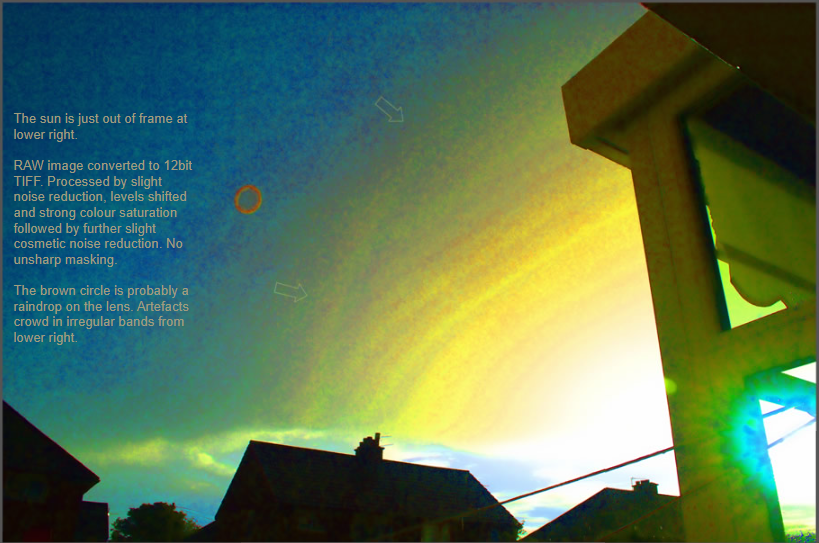
The sun is just out of frame at lower right.
RAW image converted to 12bit TIFF. Processed by slight noise reduction, levels shifted and strong colour saturation followed by further slight cosmetic noise reduction. No unsharp masking.
The brown circle is probably a raindrop on the lens. Artefacts crowd in irregular bands from lower right.
3rd Order Rainbow Hunting
Alec Jones (Bolton Halo Triangle), an avid and skilled sky observer, maybe hit the jackpot on 8th September '13 with his two images of the long hunted and exceeding rare 3rd order rainbow.
"The conditions were absolutely perfect; super bright primary and secondary, dense black clouds around the sun and pouring with rain. I had the umbrella in one hand and camera in the other. Both camera and myself soaked.. ..If this isn't a tertiary then I'm giving up atmospheric optics for tiddlywinks or some such!"
All images ©Alec Jones, shown with permission
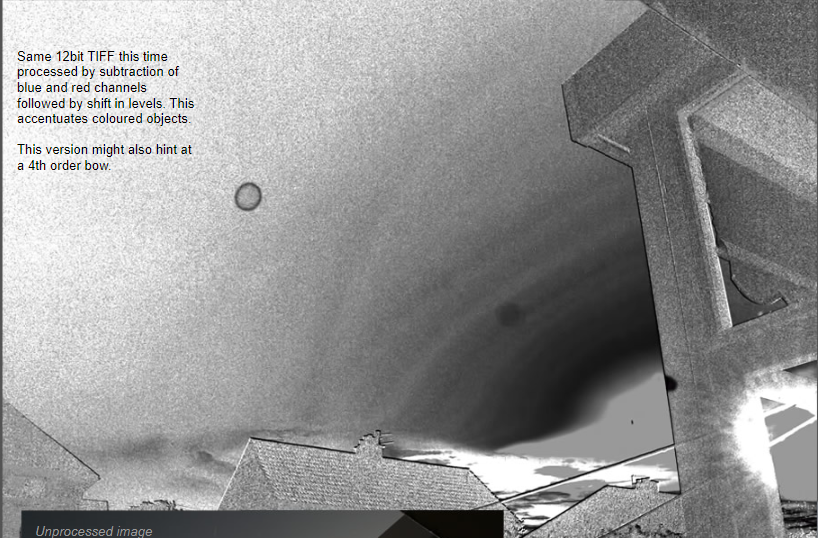
Same 12bit TIFF this time processed by subtraction of blue and red channels followed by shift in levels. This accentuates coloured objects.
This version might also hint at a 4th order bow.
The third order rainbow (three reflections inside raindrops) is almost the same size as the familiar primary bow. But it is around the sun rather than opposite. It is broader. It is fainter. It's light is swamped by the sun’s glare and by light passing through raindrops without reflection – the zero order glow.
Fiendishly difficult conditions.
Historically there are only one or two inconclusive accounts of visual sighting but no photographs. The first image was at last obtained in May 2011 by Michael Grossman, experienced observer and skilled rainbow maker, who received world-wide publicity.
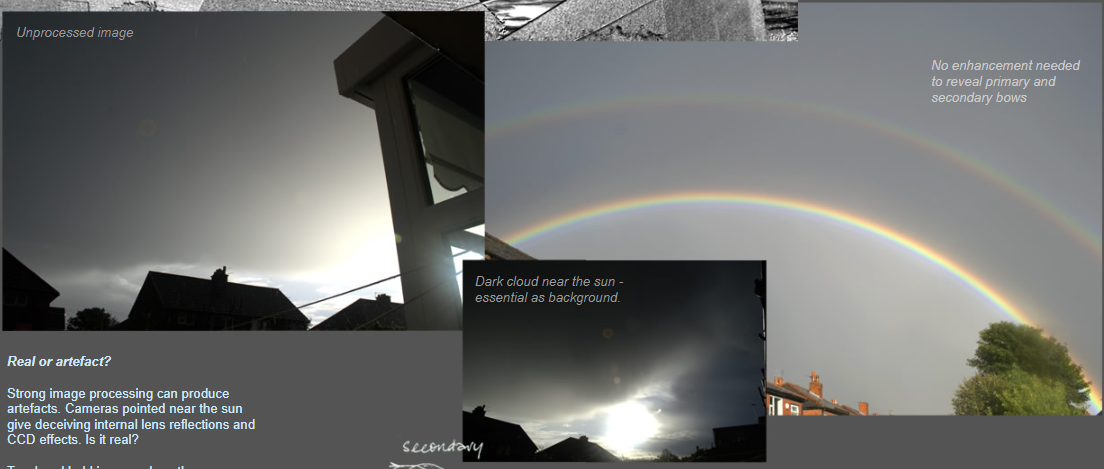
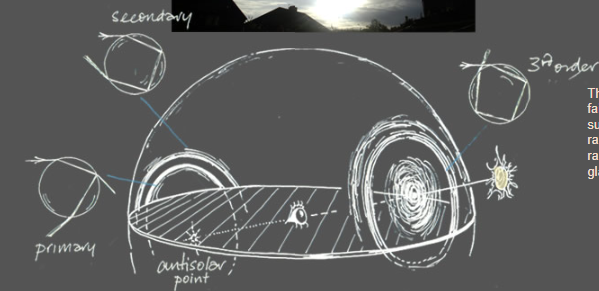
The 3rd order (surrounded by a fainter and even broader 4th order) is sunwards. It lies in the glow from rays passing straight through raindrops and the general intense glare of the sun.
Real or artefact?
Strong image processing can produce artefacts. Cameras pointed near the sun give deceiving internal lens reflections and CCD effects. Is it real?
Two hand held images show the arc. Always take several hand-held pictures of a strange phenomenon. Artefacts like lens reflections will shift and change but a real object will not.
Several different image processing routes give the same arc.
Colours are the right way around.
Geometry on the arc gives the sun position as just off the lower right hand edge. The arc is near circular except for a slight curvature difference at its indistinct top. The sun position combined with the lens focal length in the image EXIF data yields an arc radius of 43� and on the other image 41�. Theoretical radius is 42.5�. Arc width is hard to measure but is perhaps only 3.5� compared to a theory value of ~4.4�.
To be sure, we need exact reproduction of the original camera position for one of the images, exposure of a star field and subsequent calibration of the lens followed by computation of the precise sun position and then more geometry.
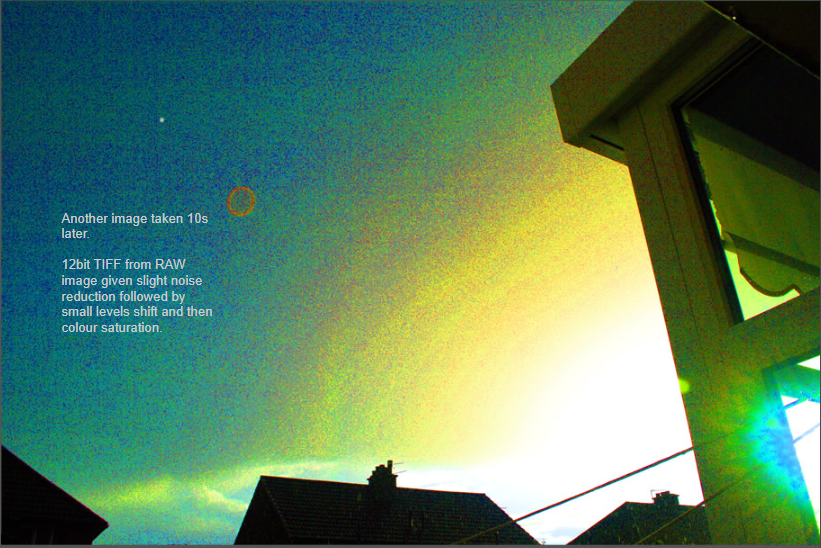
Another image taken 10s later.
12bit TIFF from RAW image given slight noise reduction followed by small levels shift and then colour saturation.
Note: this article has been automatically converted from the old site and may not appear as intended. You can find the original article here.
Reference Atmospheric Optics
If you use any of the definitions, information, or data presented on Atmospheric Optics, please copy the link or reference below to properly credit us as the reference source. Thank you!
-
<a href="https://atoptics.co.uk/blog/third-order-rainbow-opod/">Third Order Rainbow - OPOD</a>
-
"Third Order Rainbow - OPOD". Atmospheric Optics. Accessed on November 26, 2024. https://atoptics.co.uk/blog/third-order-rainbow-opod/.
-
"Third Order Rainbow - OPOD". Atmospheric Optics, https://atoptics.co.uk/blog/third-order-rainbow-opod/. Accessed 26 November, 2024
-
Third Order Rainbow - OPOD. Atmospheric Optics. Retrieved from https://atoptics.co.uk/blog/third-order-rainbow-opod/.